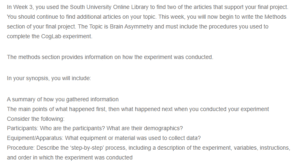Brain Asymmetry and Perception – CogLab Experiment
Summary
It is argued that the level of motor control and imagination is influenced by brain asymmetry and degree of handedness (Bobrova et al., 2021). This experiment aimed to determine if there existed a difference in brain activity and perception based on brain asymmetry. A test involving a right-handed participant was administered using CogLab 2.0. The compiled results were printed and reviewed.
Main Points
Participants
One right-handed male participant aged 28 years old was selected for the experiment. His mental health was assessed before the study was conducted. Notably, mental health influences brain function and vice-versa (Bremner et al., 2020).
Equipment/Apparatus
The experiment used the CogLab 2.0 software. The program was run on a desktop computer with a 23” display panel.
Procedure
The CogLab experiment was run on a desktop computer with a wide display and a detached keyboard. The participant was first provided with details of the experiment, and their consent was obtained as per the requirements of research ethics (Barrow et al., 2022). After the participant entered their details, he was given instructions on how the experiment will be run. This included what to do for each trial. Once the participant was ready and the CogLab was running, the participant was asked to indicate their handedness before starting the experiment. The participant was required to click on the [Space bar] to begin each trial.
The primary variable is a chimeric face made by combining two copies of the same image but with varied quality. The participant was required to press the [i] and [k] keys to indicate whether the top or bottom image respectively was the youngest. With each key press, a green box appeared around the selected image to indicate that the computer had noted the selection. Three tests were run, with each having 14 trials. The results after the end of the experiment were printed and saved.
References
Barrow, J. M., Brannan, G. D., & Khandhar, P. B. (2022). Research Ethics. StatPearls. https://www.ncbi.nlm.nih.gov/books/NBK459281/
Bobrova, E. V., Reshetnikova, V. V., Vershinina, E. A., Grishin, A. A., Bobrov, P. D., Frolov, A. A., & Gerasimenko, Y. P. (2021). The success of Hand Movement Imagination Depends on Personality Traits, Brain Asymmetry, and Degree of Handedness. Brain Sciences 2021, Vol. 11, Page 853, 11(7), 853. https://doi.org/10.3390/BRAINSCI11070853
Bremner, J. D., Moazzami, K., Wittbrodt, M. T., Nye, J. A., Lima, B. B., Gillespie, C. F., Rapaport, M. H., Pearce, B. D., Shah, A. J., & Vaccarino, V. (2020). Diet, Stress and Mental Health. Nutrients 2020, Vol. 12, Page 2428, 12(8), 2428. https://doi.org/10.3390/NU12082428
ORDER A PLAGIARISM-FREE PAPER HERE
We’ll write everything from scratch
Question 
In Week 3, you used the South University Online Library to find two of the articles that support your final project. You should continue to find additional articles on your topic. This week, you will now begin to write the Methods section of your final project. The Topic is Brain Asymmetry and must include the procedures you used to complete the CogLab experiment.

Brain Asymmetry and Perception – CogLab Experiment
The methods section provides information on how the experiment was conducted.
In your synopsis, you will include:
A summary of how you gathered information
The main points of what happened first, then what happened next when you conducted your experiment
Consider the following:
Participants: Who are the participants? What are their demographics?
Equipment/Apparatus: What equipment or material was used to collect data?
Procedure: Describe the ‘step-by-step’ process, including a description of the experiment, variables, instructions, and order in which the experiment was conducted
